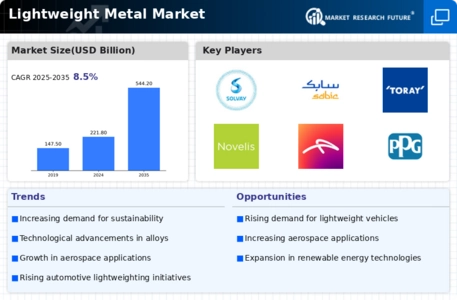Top Industry Leaders in the Lightweight Metal Market

The lightweight metal market is soaring, propelled by the relentless pursuit of efficiency and sustainability across industries. From fuel-sipping cars to sleek aeroplanes, these metals – boasting high strength-to-weight ratios – are shedding tonnes, not just grams, rewriting the rules of material selection. But within this dynamic space, a fierce competition is brewing, with established players jockeying for position and nimble newcomers disrupting the status quo.
Strategies Shaping the Landscape:
Material Mastery: Established giants like Novelis and Arconic are leveraging their vast experience and R&D muscle to refine existing alloys and develop next-generation composites. Think aluminum-lithium blends for stronger car frames and magnesium-calcium alloys for lighter aircraft seats.
Vertical Integration: Players like Alcoa are integrating upstream, securing raw material sources and downstream, investing in recycling facilities. This control over the supply chain ensures stable costs and bolsters brand image as sustainability champions.
Partnerships and Collaborations: Open innovation is key, with automakers like Ford partnering with metal producers like UACJ to develop bespoke aluminum alloys for specific vehicle models. Such collaborations accelerate material development and market adoption.
Geographical Expansion: Emerging economies like China and India, with their booming automotive and aerospace sectors, are attracting major players. Companies like Novelis are setting up new plants in these regions to cater to local demand and tap into lower production costs.
Sustainability Push: Lightweight metals are inherently green, reducing vehicle emissions and aircraft fuel consumption. Companies are highlighting this environmental benefit, earning favor with increasingly eco-conscious consumers and regulators.
Market Share Magnets:
Technological Prowess: Companies with cutting-edge processing technologies and expertise in casting, joining, and forming lightweight metals have a clear edge. Think advanced laser welding for magnesium or friction stir welding for aluminum-lithium alloys.
Cost Competitiveness: While lightweight metals offer long-term savings through fuel efficiency, upfront costs can be high. Balancing performance with affordability is crucial to win over cost-sensitive manufacturers.
Product Portfolio Breadth: Offering a diverse range of alloys and composites catering to specific industry needs, like high-strength aluminum for marine applications or corrosion-resistant magnesium for medical devices, attracts a wider customer base.
Regional Presence: A strong global footprint with production facilities and distribution networks close to key markets ensures timely deliveries and reduces logistical bottlenecks.
Sustainability Credentials: Companies with robust recycling programs and a commitment to reducing their environmental footprint resonate with today's eco-conscious consumers and regulators.
Key Companies in the Lightweight Metal market include
- DuPont
- Solvay
- Exxon Mobil Corporation
- SABIC
- Bayer AG
- Toray Industries, Inc.
- Novelis
- ArcelorMittal
- PPG Industries, Inc.,
- Alcoa Corporation
- US Magnesium LLC
- Owens Corning
- Hexcel Corporation
Industry News
-
July 2023: Tesla announces a new battery pack design incorporating lightweight aluminum and steel, boosting range and efficiency. This sends shockwaves through the automotive industry, highlighting the potential of lightweight metals in electric vehicles.
-
August 2023: Airbus partners with Arconic to develop and test new aluminum-lithium alloys for aircraft wings, aiming for a 20% weight reduction and significant fuel savings. This collaboration signals a major shift towards lightweighting in the aerospace sector.
-
September 2023: The European Union unveils stricter CO2 emission regulations for cars and vans, pushing automakers to adopt lightweight metals on a wider scale. This regulatory impetus further fuels market growth.
-
October 2023: UACJ develops a revolutionary magnesium alloy with superior strength and ductility, opening doors for its use in structural components of cars and aircraft. This breakthrough material innovation promises to disrupt the established order.









